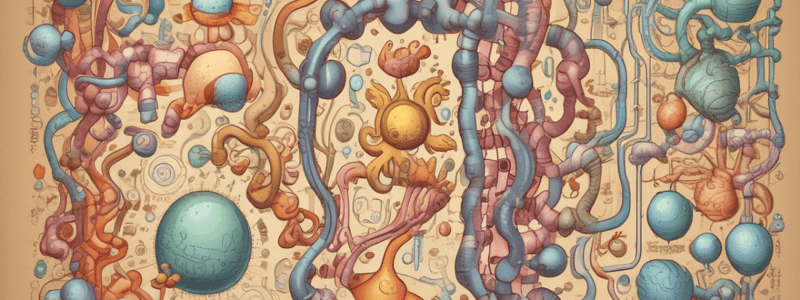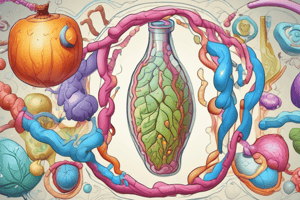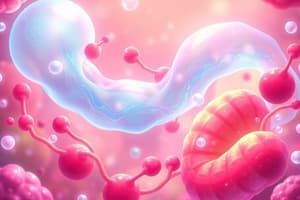Podcast
Questions and Answers
What is the effect of n-6 PUFA on cholesterol levels?
What is the effect of n-6 PUFA on cholesterol levels?
- Have no effect on cholesterol levels
- Lower cholesterol levels (correct)
- Increase TAG levels
- Increase cholesterol levels
What is associated with an increased risk of CHD?
What is associated with an increased risk of CHD?
- Low levels of TAG
- High levels of HDL cholesterol
- High levels of Lipoprotein (a) in plasma (correct)
- Low levels of LDL cholesterol
What is the main component of foam cells?
What is the main component of foam cells?
- Phospholipids
- Cholesterol (correct)
- Proteins
- Triglycerides
What is the effect of oestrogen on Lipoprotein (a) levels?
What is the effect of oestrogen on Lipoprotein (a) levels?
What is the role of scavenger receptors in foam cells?
What is the role of scavenger receptors in foam cells?
What is the initial stage of atherosclerosis?
What is the initial stage of atherosclerosis?
What is the primary form of lipid storage in the body?
What is the primary form of lipid storage in the body?
What is the rate-limiting step in fatty acid synthesis?
What is the rate-limiting step in fatty acid synthesis?
What is the primary source of energy for fatty acid synthesis?
What is the primary source of energy for fatty acid synthesis?
What is the role of insulin in fatty acid synthesis?
What is the role of insulin in fatty acid synthesis?
What is the effect of malonyl CoA on fatty acid oxidation?
What is the effect of malonyl CoA on fatty acid oxidation?
What is the role of citrate in fatty acid synthesis?
What is the role of citrate in fatty acid synthesis?
What is the primary site of fatty acid synthesis?
What is the primary site of fatty acid synthesis?
What is the role of oxaloacetate in fatty acid synthesis?
What is the role of oxaloacetate in fatty acid synthesis?
What is the primary function of Fatty acid synthetase in fatty acid synthesis?
What is the primary function of Fatty acid synthetase in fatty acid synthesis?
Which of the following lipoproteins is responsible for carrying dietary triglycerides from the intestine to the liver?
Which of the following lipoproteins is responsible for carrying dietary triglycerides from the intestine to the liver?
What is the primary role of apoproteins in lipoprotein metabolism?
What is the primary role of apoproteins in lipoprotein metabolism?
What is the rate-limiting step in cholesterol synthesis?
What is the rate-limiting step in cholesterol synthesis?
What is the consequence of a deficiency in LDL receptors?
What is the consequence of a deficiency in LDL receptors?
Which of the following is an example of a genetic hyperlipoproteinaemia?
Which of the following is an example of a genetic hyperlipoproteinaemia?
What is the primary function of lipoprotein lipase?
What is the primary function of lipoprotein lipase?
What is the primary mechanism by which statins inhibit cholesterol synthesis?
What is the primary mechanism by which statins inhibit cholesterol synthesis?
Flashcards are hidden until you start studying
Study Notes
Lipid Synthesis and Transport
- Energy from excess food is stored as glycogen (carbohydrate) and triacylglycerol (TAG) in the liver and adipose tissue, respectively.
- Insulin stimulates fatty acid synthesis from acetyl CoA in the fed state.
- The first step in fatty acid synthesis is the conversion of acetyl CoA to malonyl CoA, catalyzed by acetyl CoA carboxylase, which is the rate-limiting step and inhibited by carnitine transferase.
Fatty Acid Synthesis
- Fatty acid synthesis requires NADPH, which is provided by the hexose monophosphate shunt.
- Fatty acid synthetase is the enzyme responsible for fatty acid synthesis.
TAG Synthesis
- TAG is synthesized from glycerol phosphate and three fatty acids in the liver cell.
- Apoproteins are involved in the synthesis of TAG.
Lipoprotein Structure
- Lipoproteins have an inner core containing triglycerides and cholesterol esters, surrounded by a single layer of phospholipids, cholesterol, and apoproteins.
- Lipoproteins are necessary for lipid transport in the blood, as lipids are insoluble in water.
Classes of Lipoproteins
- Chylomicrons: largest and lowest density lipoproteins, carrying mainly dietary TAG.
- VLDL (Very Low Density Lipoprotein): carries mainly endogenous TAG.
- LDL (Low Density Lipoprotein): carries mainly cholesterol to the tissues.
- HDL (High Density Lipoprotein): carries mainly cholesterol from the tissues to the liver.
Cholesterol Synthesis
- Cholesterol synthesis is controlled by its own synthesis and the number of LDL receptors on the cell surface.
- The rate-limiting step in cholesterol synthesis is the conversion of HMG-CoA to mevalonate, which is inhibited by statins.
LDL Receptors
- LDL receptors are important for removing LDL from the circulation through receptor-mediated endocytosis.
- Deficiency of LDL receptors leads to familial hypercholesterolaemia and very high blood cholesterol levels.
Hyperlipidaemias
- Hypercholesterolaemia: high levels of cholesterol in the blood.
- Hypertriglyceridaemia: high levels of triglycerides in the blood.
- Genetic disposition and environmental factors (diet, lifestyle) can contribute to hyperlipidaemias.
Examples of Genetic Hyperlipoproteinaemias
- Defective LDL receptor: high LDL in blood.
- Lipoprotein lipase deficiency: high chylomicrons and VLDL.
- Deficiency of C-II: high chylomicrons and VLDL.
- Deficiency of apoproteins involved in remnant uptake: high chylomicron and VLDL remnant.
Risk Factors for Secondary Hyperlipoproteinaemias
- Obesity.
- Diabetes mellitus type 2.
- Dietary cholesterol and fatty acid (SFA vs PUFA).
- Alcoholism.
Lipoprotein (a)
- Lp(a) is associated with increased risk of CHD.
- Lp(a) is a lipoprotein containing LDL and apoprotein a.
Atherosclerosis
- Atherosclerosis is a complex process involving inflammation and proliferation of smooth muscle in the artery wall.
- Plaque formation is the result of foam cell accumulation, which is rich in cholesterol.
Modified LDL
- Modified (oxidised) LDL is not recognised by the normal receptor but is taken up by scavenger receptors in foam cells, leading to accumulation of cholesterol.
Studying That Suits You
Use AI to generate personalized quizzes and flashcards to suit your learning preferences.




